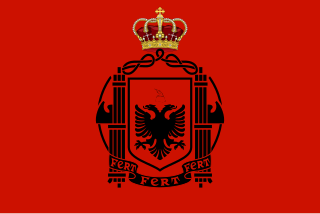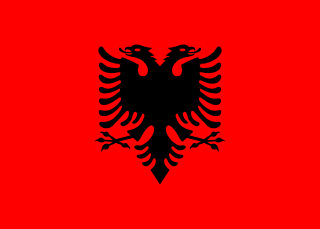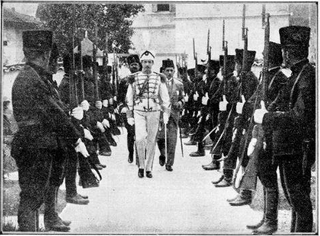
The Albanian Armed Forces (Albanian: Forcat e Armatosura të Republikës së Shqipërisë are the military of Albania and were formed after the declaration of independence in 1912. Today, it consists of the General Staff, the Albanian Land Force, Albanian Air Force and the Albanian Naval Force.
A general officer is an officer of high rank in the armies, and in some nations' air forces, space forces, and marines or naval infantry.

Military ranks are a system of hierarchical relationships, within armed forces, police, intelligence agencies or other institutions organized along military lines. The military rank system defines dominance, authority, and responsibility in a military hierarchy. It incorporates the principles of exercising power and authority into the military chain of command—the succession of commanders superior to subordinates through which command is exercised. The military chain of command constructs an important component for organized collective action.
The People's Liberation Army (PLA) has not always used ranks or insignia. In common with the practice of the Red Army at the time of its founding in 1927, neither were used until 1955 when a system of ranks was established. As a result of the Cultural Revolution, ranks were abolished in May 1965. After the Sino-Vietnamese War of 1979, reforms in the PLA began to be made to professionalize the armed forces once more. The 1984 Military Service Law provided for the resumption of rank, but disagreements on what ranks were to be used and who would receive them caused the revival of rank to be delayed until 1988. The following ranks and their respective insignia shown are those used by the People's Liberation Army Ground Force.
The term used in the Royal Air Force (RAF) to refer to all ranks below commissioned officer level is other ranks (ORs). It includes warrant officers (WOs), non-commissioned officers (NCOs) and airmen.

The military ranks of the Soviet Union were those introduced after the October Revolution of 1917. At that time the Imperial Russian Table of Ranks was abolished, as were the privileges of the pre-Soviet Russian nobility.

These are the official Royal Navy Officer ranks ordered by rank. These ranks are part of the NATO/United Kingdom ranks, including modern and past. Past insignia is in italic.

The Albanian Kingdom was the official name of Albania between 1928 and 1939. Albania was declared a monarchy by the Constituent Assembly, and President Ahmet Bej Zogu was declared King Zog I. The kingdom was supported by the fascist regime in Italy, and the two countries maintained close relations until Italy's sudden invasion of the country in 1939. Zog fled into exile and never saw his country again. The Communist Party of Labor of Albania gained control of the country toward the end of World War II, established a communist government, and formally deposed Zog.

The Italian protectorate of Albania, also known as the Kingdom of Albania or Greater Albania, existed as a protectorate of the Kingdom of Italy. It was practically a union between Italy and Albania, officially led by Italy's King Victor Emmanuel III and its government: Albania was led by Italian governors, after being militarily occupied by Italy, from 1939 until 1943. During this time, Albania ceased to exist as an independent country and became an autonomous part of the Italian Empire. Officials intended to make Albania part of a Greater Italy by assimilating Albanians as Italians and colonizing Albania with Italian settlers from the Italian Peninsula to transform it gradually into an Italian land.
The Military ranks of Romania are the military insignia used by the Romanian Armed Forces.

The Italian invasion of Albania was a brief military campaign which was launched by the Kingdom of Italy against the Albanian Kingdom in 1939. The conflict was a result of the imperialistic policies of the Italian prime minister and dictator Benito Mussolini. Albania was rapidly overrun, its ruler King Zog I went into exile in neighboring Greece, and the country was made a part of the Italian Empire as a protectorate in personal union with the Italian Crown.

The following outline is provided as an overview of and topical guide to Albania:

The Royal Albanian Army was the army of the Albanian Kingdom and King Zog I of the Albanians from 1928 until 1939. Its commander-in-chief was King Zog; its commander was General Xhemal Aranitasi; its Chief of Staff was General Gustav von Myrdacz. The army was mainly financed by Italy from 1936 to 1939.
The Military ranks of Albania are the military insignia used by the Albanian Armed Forces.

Aziz Çami was an Albanian army officer and Balli Kombëtar commander. In 1920 he was a commander in the Vlora War. In the mid-1920s he was exiled after the restoration of monarchy as he was a supporter of Fan Noli and in 1931 he was arrested for an assassination attempt against King Zog I. During World War II he joined the ranks of the Balli Kombëtar and fought with Nazi Germany. He was assassinated in Tiranë in 1943.

The Arm of Gendarmerie was a gendarmerie force created after the proclamation of independence from the Ottoman Empire of Albania on 28 November 1912.
The Military ranks of the Kingdom of Yugoslavia were the military insignia used by the Royal Yugoslav Armed Forces. It replaced the ranks of the Kingdom of Serbia following the unification of the Kingdom of Serbia into Kingdom SHS. After the proclamation of the Socialist Federal Republic of Yugoslavia, the ranks were replaced by the Yugoslav People's Army ranks.
The Military ranks of the People's Socialist Republic of Albania were the military insignia used by the Albanian People's Army. After the Second World War, the Military ranks of the Albanian Kingdom were abandoned and replaced with insignia and ranks inspired by the Soviet military ranks. Albania used these ranks until May 1966, when military ranks were abolished altogether following Chinese example and based on doctrines of guerilla warfare.























